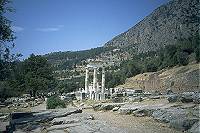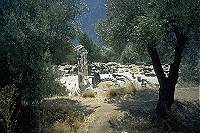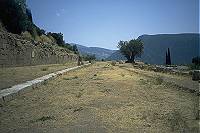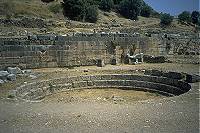|
Back
to Illustrated Sites of Greece
Castalian
Spring
Corycian
Cave and Environs
Marmara
at Delphi
The Delphi
Museum Gallery
Mount
Parnassos
Up the
Sacred Way
The Stadium at
Delphi
The Temple of
Apollo
The Theater at
Delphi
|
 |
|
 Dr. J's
Illustrated Dr. J's
Illustrated
Marmara at Delphi
|
 The
Sanctuary of Athena, "Marmara," consists of the ruins of several buildings, most
of which date to the early 4th century BC, including the Treasury of Massilia, our
Marseilles. The original Temple of Athena Pronaia ("In Front of the Temple - of
Apollo"), sometimes called Athena Pronoia ("Forethought"), was destroyed by
the earthquake in 480 BC that scared the wits out of the Persians (Herodotus 8.39.2) and
was rebuilt in c. 360 BC. The
Sanctuary of Athena, "Marmara," consists of the ruins of several buildings, most
of which date to the early 4th century BC, including the Treasury of Massilia, our
Marseilles. The original Temple of Athena Pronaia ("In Front of the Temple - of
Apollo"), sometimes called Athena Pronoia ("Forethought"), was destroyed by
the earthquake in 480 BC that scared the wits out of the Persians (Herodotus 8.39.2) and
was rebuilt in c. 360 BC. |
 Although
the Temple of Athena Pronaia was the focus of worship here, it is this lovely round
building (the tholos) - built in 390-380 BC and partially reconstructed in 1938 - that
gets all the attention. No one has figured out its original function. Although
the Temple of Athena Pronaia was the focus of worship here, it is this lovely round
building (the tholos) - built in 390-380 BC and partially reconstructed in 1938 - that
gets all the attention. No one has figured out its original function. |
 The
Gymnasium lies to the NW of Marmara. The xystos is the covered track where the athletes
practiced running for the Pythian Games at Delphi, one of four Panhellenic Games held in
Greece. The Romans replaced the original Doric columns with Ionic ones, thus disproving
the old adage that you can't put a square peg in a round hole. Below and to the right of
the xystos is the palaestra, the outdoor track. The
Gymnasium lies to the NW of Marmara. The xystos is the covered track where the athletes
practiced running for the Pythian Games at Delphi, one of four Panhellenic Games held in
Greece. The Romans replaced the original Doric columns with Ionic ones, thus disproving
the old adage that you can't put a square peg in a round hole. Below and to the right of
the xystos is the palaestra, the outdoor track. |
 Surviving
also is this bath, the best preserved Greek pool of the Classical period. Cold water ran
down from the mountain, poured out through lion-head spouts (note the holes in the wall)
into ten basins (along the wall), and the surplus water ran into the pool, where the
athletes swam and bathed. Decadent hot baths were added later by the Romans but have not
survived. Surviving
also is this bath, the best preserved Greek pool of the Classical period. Cold water ran
down from the mountain, poured out through lion-head spouts (note the holes in the wall)
into ten basins (along the wall), and the surplus water ran into the pool, where the
athletes swam and bathed. Decadent hot baths were added later by the Romans but have not
survived. |
|
